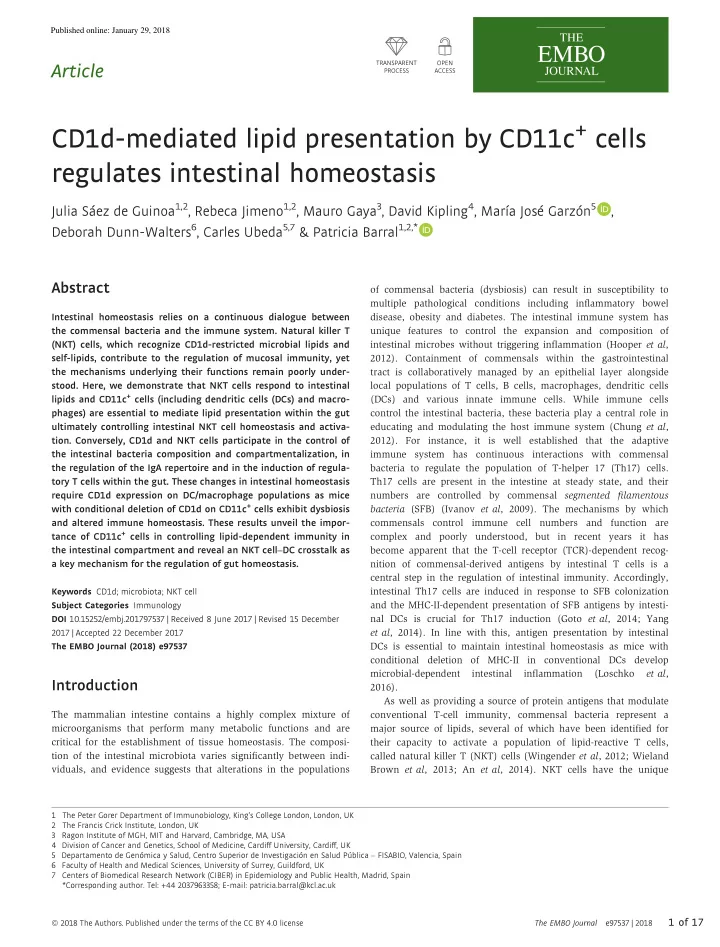

Published online: January 29, 2018 Article CD 1 d-mediated lipid presentation by CD 11 c + cells regulates intestinal homeostasis Julia Sáez de Guinoa 1 , 2 , Rebeca Jimeno 1 , 2 , Mauro Gaya 3 , David Kipling 4 , María José Garzón 5 , Deborah Dunn-Walters 6 , Carles Ubeda 5 , 7 & Patricia Barral 1 , 2 ,* Abstract of commensal bacteria (dysbiosis) can result in susceptibility to multiple pathological conditions including inflammatory bowel Intestinal homeostasis relies on a continuous dialogue between disease, obesity and diabetes. The intestinal immune system has the commensal bacteria and the immune system. Natural killer T unique features to control the expansion and composition of (NKT) cells, which recognize CD 1 d-restricted microbial lipids and intestinal microbes without triggering inflammation (Hooper et al , self-lipids, contribute to the regulation of mucosal immunity, yet 2012). Containment of commensals within the gastrointestinal the mechanisms underlying their functions remain poorly under- tract is collaboratively managed by an epithelial layer alongside stood. Here, we demonstrate that NKT cells respond to intestinal local populations of T cells, B cells, macrophages, dendritic cells lipids and CD 11 c + cells (including dendritic cells (DCs) and macro- (DCs) and various innate immune cells. While immune cells phages) are essential to mediate lipid presentation within the gut control the intestinal bacteria, these bacteria play a central role in ultimately controlling intestinal NKT cell homeostasis and activa- educating and modulating the host immune system (Chung et al , tion. Conversely, CD 1 d and NKT cells participate in the control of 2012). For instance, it is well established that the adaptive the intestinal bacteria composition and compartmentalization, in immune system has continuous interactions with commensal the regulation of the IgA repertoire and in the induction of regula- bacteria to regulate the population of T-helper 17 (Th17) cells. tory T cells within the gut. These changes in intestinal homeostasis Th17 cells are present in the intestine at steady state, and their require CD 1 d expression on DC/macrophage populations as mice numbers are controlled by commensal segmented filamentous with conditional deletion of CD 1 d on CD 11 c + cells exhibit dysbiosis bacteria (SFB) (Ivanov et al , 2009). The mechanisms by which and altered immune homeostasis. These results unveil the impor- commensals control immune cell numbers and function are tance of CD 11 c + cells in controlling lipid-dependent immunity in complex and poorly understood, but in recent years it has the intestinal compartment and reveal an NKT cell – DC crosstalk as become apparent that the T-cell receptor (TCR)-dependent recog- a key mechanism for the regulation of gut homeostasis. nition of commensal-derived antigens by intestinal T cells is a central step in the regulation of intestinal immunity. Accordingly, Keywords CD 1 d; microbiota; NKT cell intestinal Th17 cells are induced in response to SFB colonization and the MHC-II-dependent presentation of SFB antigens by intesti- Subject Categories Immunology DOI 10 . 15252 /embj. 201797537 | Received 8 June 2017 | Revised 15 December nal DCs is crucial for Th17 induction (Goto et al , 2014; Yang 2017 | Accepted 22 December 2017 et al , 2014). In line with this, antigen presentation by intestinal DCs is essential to maintain intestinal homeostasis as mice with The EMBO Journal ( 2018 ) e 97537 conditional deletion of MHC-II in conventional DCs develop microbial-dependent intestinal inflammation (Loschko et al , Introduction 2016). As well as providing a source of protein antigens that modulate The mammalian intestine contains a highly complex mixture of conventional T-cell immunity, commensal bacteria represent a microorganisms that perform many metabolic functions and are major source of lipids, several of which have been identified for critical for the establishment of tissue homeostasis. The composi- their capacity to activate a population of lipid-reactive T cells, tion of the intestinal microbiota varies significantly between indi- called natural killer T (NKT) cells (Wingender et al , 2012; Wieland viduals, and evidence suggests that alterations in the populations Brown et al , 2013; An et al , 2014). NKT cells have the unique 1 The Peter Gorer Department of Immunobiology, King ’ s College London, London, UK 2 The Francis Crick Institute, London, UK 3 Ragon Institute of MGH, MIT and Harvard, Cambridge, MA, USA 4 Division of Cancer and Genetics, School of Medicine, Cardiff University, Cardiff, UK 5 Departamento de Genómica y Salud, Centro Superior de Investigación en Salud Pública – FISABIO, Valencia, Spain 6 Faculty of Health and Medical Sciences, University of Surrey, Guildford, UK 7 Centers of Biomedical Research Network (CIBER) in Epidemiology and Public Health, Madrid, Spain *Corresponding author. Tel: + 44 2037963358 ; E-mail: patricia.barral@kcl.ac.uk 1 of 17 ª 2018 The Authors. Published under the terms of the CC BY 4 . 0 license The EMBO Journal e 97537 | 2018
Recommend
More recommend